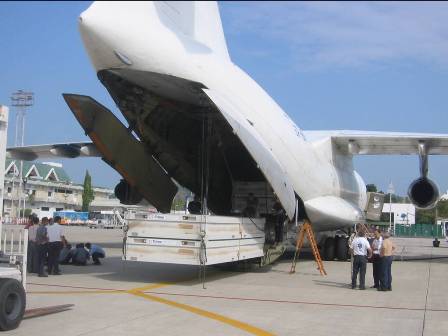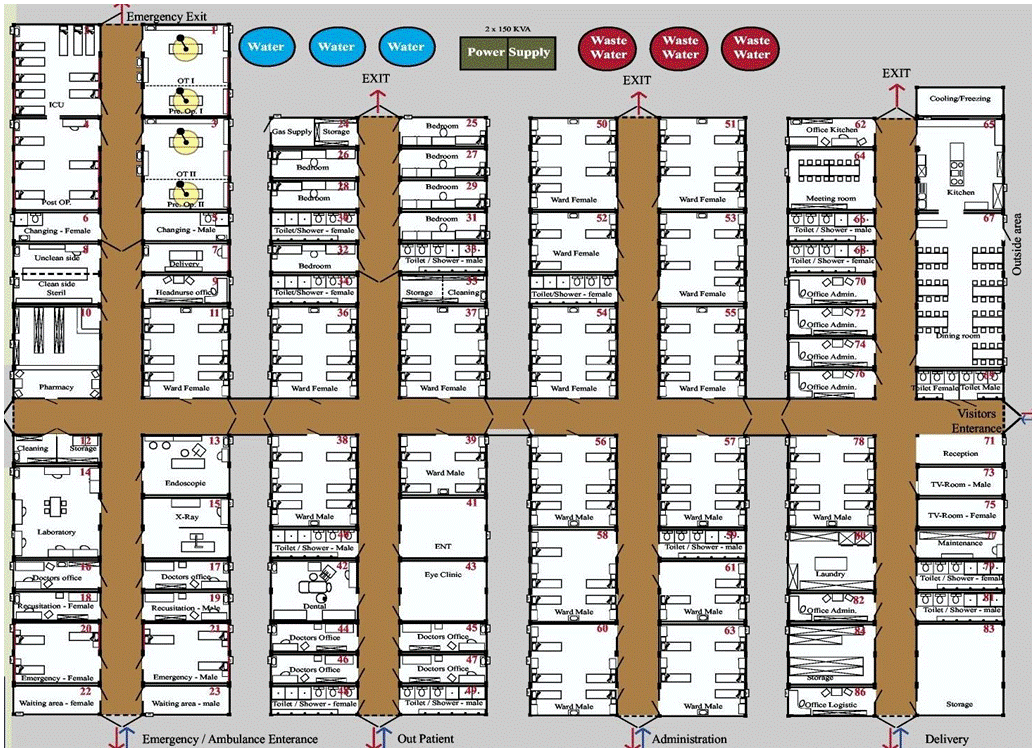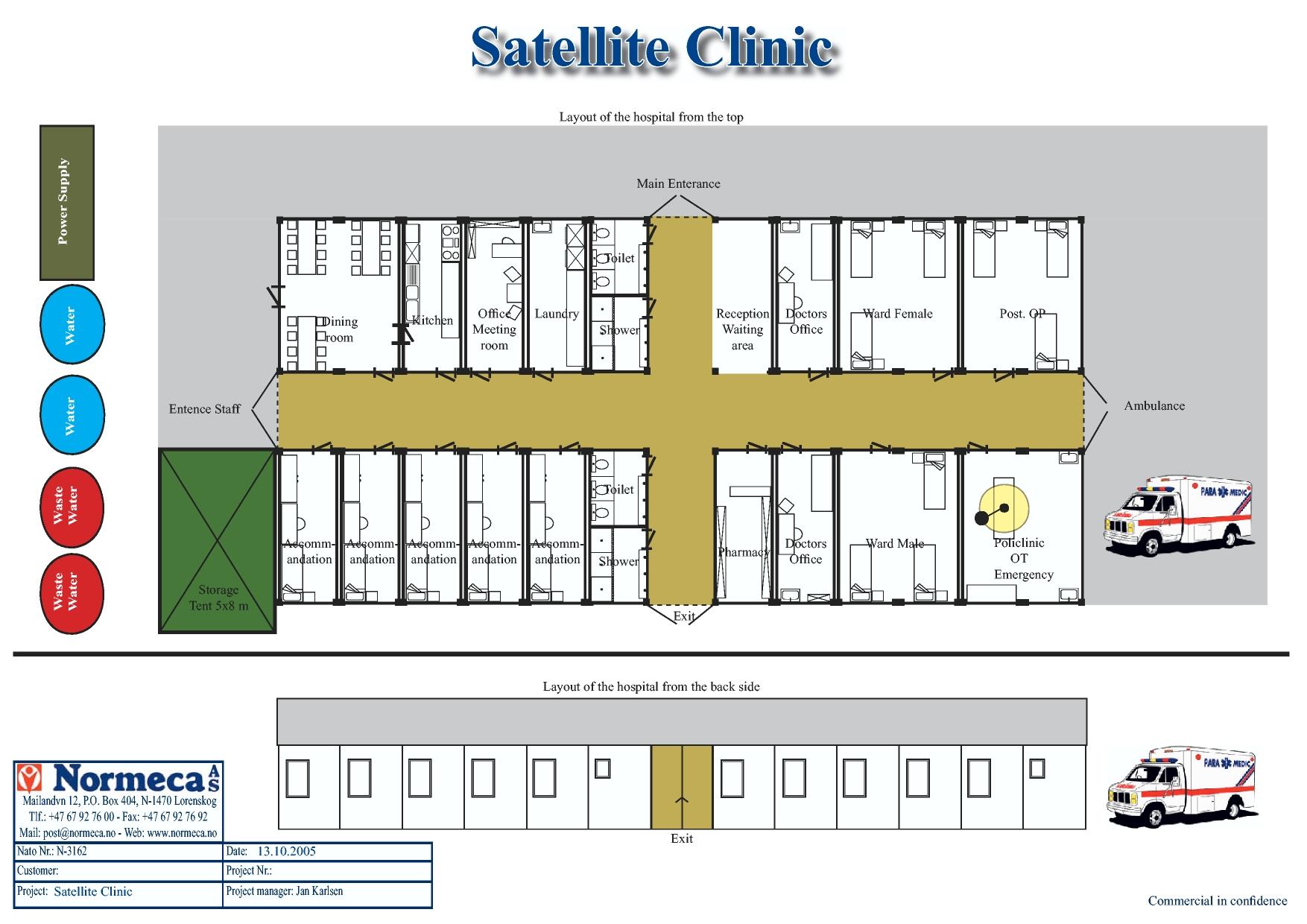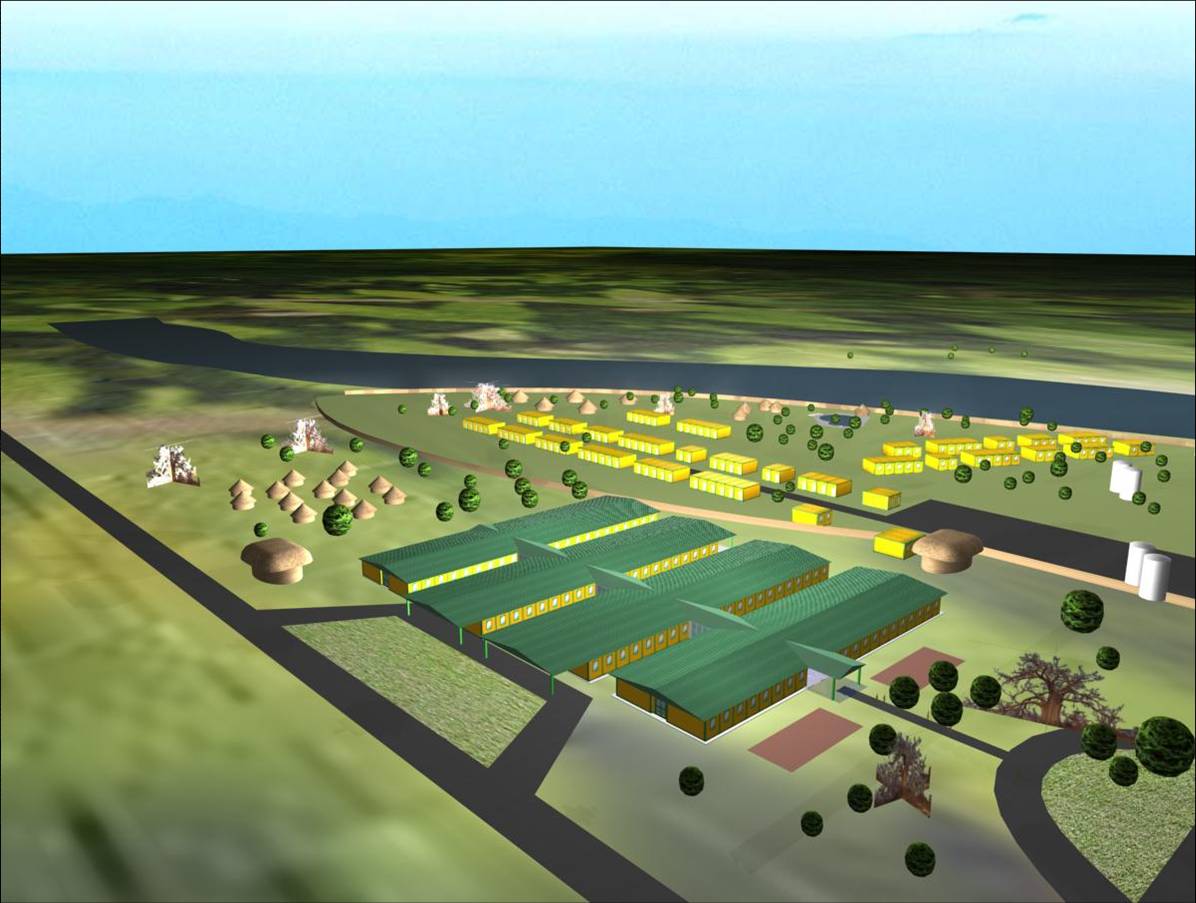3.
SEMI-MOBILE
EMERGENCY HOSPITAL WITH
CLINICS
SEMI-MOBILE EMERGENCY HOSPITAL
Concept Outline
Every disaster and emergency situation has two main phases; emergency relief immediately after the disaster and aid for reconstruction. For perhaps obvious reasons these two have been separated clearly in terms of aid provided. However, Normeca would argue that it is not only possible but also highly recommendable to see these two connected ensuring a longer-term horizon in midst of the emergency situation. This should be of particular interest to NGOs, governments providing or paying for aid and support in an emergency situation and other aid institutions.
Introduction
Normeca AS objective with this concept is to fulfil both short term and immediate needs for medical treatment in a disaster area or areas with immediate need for relief for other reasons, while at the same time securing longer-term need and interest being taken into account.
Mobile and primarily tent-based hospitals have become state of the art wherever medical relief is needed after a disaster and in an emergency situation. They are quite inadequate for longer-term operation and were of course never intended for this.
Normeca AS is introducing a hybrid model: A central hospital unit and smaller medical clinics all based on flat-packed containers that may be connected and designed according to the need and purpose with a very short building period. The concept was tried and tested in Thailand after the Tsunami. Here, the victims’ identification centre was built using 64 flat-packed containers and built in 10 days including an extensive infrastructure. Containers of this kind may have a lifetime up to 20 years or more dependent on satisfactory maintenance.
Another key ingredient in this flexible concept is the use of local resources to prepare all infrastructure and build the semi-stationary hospital. Also, emphasis has been placed on using standard material and equipment of various kinds that may be purchased locally. Furthermore, medical and other equipment may be moved to an ordinary hospital upon closing, assuming such a hospital has been built during the reconstruction phase.
The smaller medical clinics or satellites are based on the same principles and should be placed in an area around the central hospital unit i.e. in a radius of 50 to 150 km depending on the emergency situation and population etc. The concept also includes ambulatory communication between the satellite and the central unit. This way, the turnkey solution will provide relief to a large number of people in a very short time. Also, a large number of people that would not require the services offered by a hospital may still get their medical support at the medical clinic and thus not overburdening the central unit more than need be and increasing the capacity to focus more on the more severely injured people.
When the units are to be disassembled and moved alternatively split into smaller units, this is easily done in this flexible and modular solution.
On the following pages, we have briefly described the many modules and functions included in this flexible solution.
The Central Hospital Unit
The hospital unit consists of 12 different departments fully customisable to the various needs and customer preferences. The number of beds may be increased or reduced according to the usage. Based on more than 20 years of experience in the business of medical equipment, Normeca AS has prepared standard inventory for these departments and all equipment meets Scandinavian standards for hospital equipment.
Equipment lists may be altered and adjusted according to the customers’ preferences. Normeca AS has an extensive network of manufacturers and suppliers of medical equipment all over the world. We can thus meet any requirement in any price range and quality.
 |
||
100 BEDS HOSPITAL

Operating Department
The operating department consists of 2 operating theatres and 2 pre-operating rooms. Hence and under normal conditions, the hospital has a capacity for 12 to 60 operations each day depending on type of surgery. In addition, the pre-operating rooms may be converted to operating theatres if needed, increasing the capacity to 24 to 120 operations per day. Limiting factors are only instrumentation, sterilization unit and medical personnel.
The department is well equipped with state of the art equipment within anaesthesia, ventilation, operating tables and –lamps, diathermia, vacuum pumps, instrumentation and monitoring.
Intensive Care Department (ICU)
The ICU department is fully equipped to meet any situation with up to date patient monitoring, respirators, infusion pumps, rail mounted suction, oxygen flow meters and other required equipment for 5 beds that may be extended with a further 2 or 3 if necessary.
Post-OP Department
This department has 5 beds and is intended for patients awakening after operation and not in need of particular monitoring and care. The department is still well equipped with the relevant and required equipment.
Bedpost
Two bedposts are included; one for men and one for women, a total of 100 beds. All necessary equipment and inventory to run the department is included like mattresses, bed linen and simpler medical equipment necessary for this unit.
Delivery Room
A simple delivery room is included and placed in connection with the operating departments. It contains the required delivery table and equipment and the possibility to provide N2O.
Gynaecological department
A separate room for gynaecological examination of patients is included with all necessary equipment.
Sterile unit
The hospital is equipped with a very good sterile unit fully equipped with necessary autoclaves, equipment for packeting and other inventory.
Pharmacy
Room is also available for and equipment included for a Pharmacy. This will have all necessary inventories with dedicated cooler for medicines etc.
X-Ray Unit
The X-Ray unit is very well equipped with a fixed digital x-ray machine in addition to a more simple mobile x-ray machine that may be moved around in the hospital.
Laboratory
The laboratory is equipped with the most necessary equipment but is excluding the more advanced equipment for various analyses etc.
Doctors’ Office
The hospital includes a total of 6 doctor’s offices or examination rooms; 3 for men and 3 for women. They are all equipped with relevant medical equipment and other inventory in addition to PC and printer.
Emergency Reception
Two emergency rooms; one for men and one for women are included. In addition there are two resuscitation rooms also here, one for men and one for women. All rooms are equipped with the necessary emergency equipment.
Endoscopies room
A separate room for endoscopies has been made available with equipment for gastro-endoscopies including monitors and the possibility to watch duo.
Dentists office
A dental room is included with necessary equipment including a dental unit, instruments and other related equipment.
Oral Department
A department for examination of ears, nose and throat is included in the hospital with all necessary and required equipment.
Eye Department
The hospital has a good department for eye examination with relevant inventory and equipment.
Staff Quarters
A separate wing for staff is included with 10 beds that easily can be increased to 20 beds by converting the rooms to double rooms. These quarters are for security personnel and visiting professionals.
Kitchen
The hospital is equipped with good and modern kitchen facilities for preparing food to 100 patients and all staff. In addition, there is a canteen with room for approximately 50 people. All relevant inventories from cutlery to dishwasher are included. There is also included a 20” freezing/cooling container for food storage.
Laundry
The hospital has its own laundry with large professional washing machines and dryers in addition to ironing facilities.
Maintenance Department
A separate workshop with necessary equipment for servicing medical equipment and the rest of the hospital is included.
Administration Offices
Four offices for administration is included. These are equipped with necessary office inventory including PC and printer.
Meeting Room
A meeting room is included with relevant inventory e.g. chairs and table, projector, flip-over etc.
TV – Restroom for staff
Two restrooms for staff are equipped with relevant inventory including TV; one room for men and one for women.
Cleaning
A number of smaller cleaning rooms has been distributed across the hospital equipped for cleaning of the hospital.
Logistics/Warehouse
The hospital has a sufficient capacity for storage of supplies, consumables etc. with office space including PC and printer.
Personal Hygiene
A module for personal hygiene is included both for patients and staff. The module contains everything from soap and shampoo to towels and other relevant material.
IT and Communication
The hospital has its own switchboard that connects to the local telephone cables in the area. This enables telephone- and data communication from every office and department where this is needed.
Electricity and Water
The hospital can connect to the local net for electricity and water. If this does not exist, the hospital will be configured with two 200 KVA generators. This should be sufficient also for heating and A/C. In addition, the hospital comes fully equipped with necessary piping for water and drainage. In areas where the temperature gets below 0°c, the piping is provided with heating cables and –elements for use in the water tanks. The water system includes tanks for clean water inclusive of filters, pumps and septic tanks.
Heating and A/C
All containers are equipped with wall mounted heating panels and A/C for every room. All corridors are tiled.
Consumables
The hospital is provided with consumables for 2 to 3 months operation. These include medical consumables, consumables for dentists in addition to necessary washing powder, paper towels and more.
Management
If required, the hospital may be supplied with management for a shorter or longer period. This may even include professional staff like doctors and nurses.
Standard management includes project manager, logistics manager, medical manager (doctor or senior nurse), a medical engineer and a responsible for maintenance of buildings and other installations (preferably electrician).
Satellite Clinics
Each satellite consists of 22 containers (to be reduced according to need). The clinic includes 2 doctors’ offices or examination rooms, a simple pharmacy, a combined outpatient/operating room/delivery and emergency room. In addition, the clinic contains 2 beds for post op and 6 beds for patients (3 for men, 3 for women). It includes also a simple kitchen and restroom. The clinic is equipped as the hospital but related to the departments.

It is recommended that each clinic is set up with an ambulance. Both new and used ambulances may be supplied.
Guarantee
The hospital with all equipment and material is supplied with a 1-year guarantee against malfunctions from manufacturing. All malfunctions and errors will be corrected within 72 hours if other is not agreed from situation to situation. Proviso is made for local circumstances and possibilities for transport of both personnel and equipment/parts.
Included with the hospital, are a set of spare parts that based on experience will be most in demand.
Mailandvn. 12, P.O. Box 404, 1470 Loerenskog, Norway
Phone: +47 67 92 76 00, Fax: +47 67 92 76 91
E-mail: post@normeca.no
